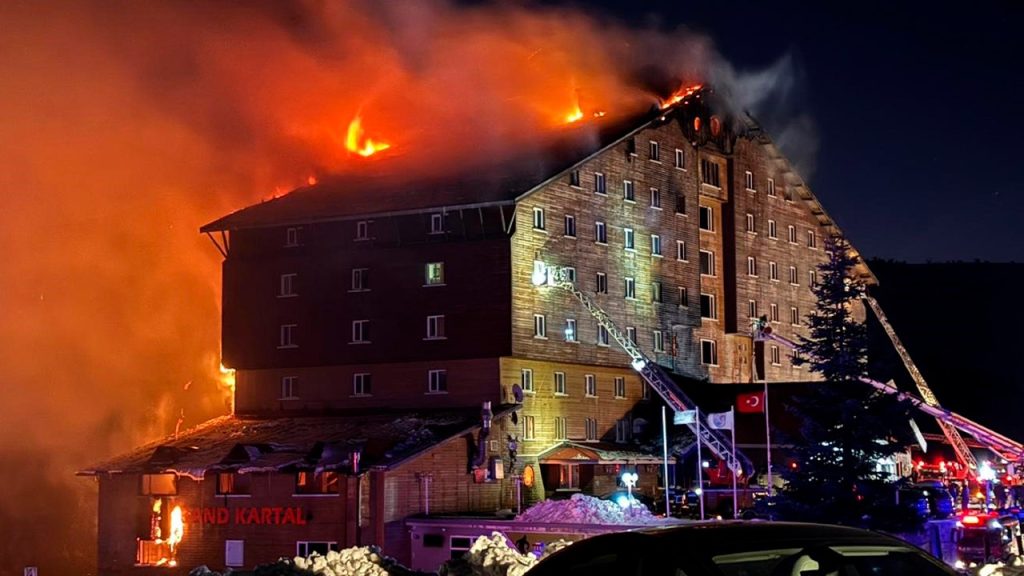The Grand Kartal Hotel, a twelve-story establishment nestled in the popular ski resort of Kartalkaya, Bolu province, Turkey, became the scene of a devastating tragedy in the early hours of Tuesday morning. A fire, erupting around 3:30 a.m. in the hotel’s restaurant, rapidly spread through the building, claiming the lives of at least 66 individuals and injuring 51 others. The heartbreaking incident occurred during the school semester break, a period when the region’s hotels are typically filled with vacationers. The sheer scale of the disaster prompted swift government action, with six prosecutors appointed to lead a thorough investigation into the cause of the fire and the circumstances surrounding the tragic loss of life.
The fire’s rapid engulfment of the hotel left many guests trapped and desperate. Horrifying accounts from survivors and witnesses paint a picture of chaos and panic as people struggled to escape the inferno. Some guests resorted to desperate measures, using bedsheets and blankets in attempts to climb down the exterior of the building. Tragically, at least two individuals lost their lives after jumping from the upper floors in a desperate bid to escape the flames. The intense heat and smoke hampered escape efforts, creating a nightmarish scenario for those trapped inside. The delayed arrival of firefighting teams, estimated to be approximately an hour after the fire’s outbreak, further exacerbated the situation and likely contributed to the high casualty count.
The initial investigation and eyewitness accounts raise serious concerns about the hotel’s fire safety measures. Reports suggest that the hotel’s fire detection system malfunctioned, failing to alert guests to the imminent danger. This critical failure deprived occupants of crucial time to evacuate and likely contributed significantly to the tragic outcome. Furthermore, the hotel’s construction, featuring wooden cladding on its exterior in a chalet-style design, is suspected to have accelerated the fire’s spread. This, coupled with the hotel’s location on a cliffside, presented substantial challenges to firefighting efforts, hindering access and complicating the operation to control the blaze.
The aftermath of the fire presented a scene of devastation. The hotel’s upper floors and roof were ravaged by the flames, while the lobby bore the stark marks of the inferno. Shattered glass from the entrance and windows, a charred reception desk, and a chandelier crashed to the ground all testified to the intensity of the fire. The smoke-blackened walls and debris further underscored the magnitude of the tragedy. The sheer scale of the loss of life and the harrowing accounts of those who survived paint a grim picture of the terror and desperation that gripped the hotel as the fire raged.
Beyond the immediate investigation into the Grand Kartal Hotel fire, this tragedy underscores the critical importance of stringent fire safety regulations and their rigorous enforcement in all public accommodations, particularly in high-risk environments such as multi-story hotels located in remote areas. The failure of the fire detection system, the potentially flammable exterior cladding, and the challenges posed by the hotel’s location on a cliffside all highlight potential vulnerabilities that require careful consideration and proactive measures to prevent similar disasters in the future. This tragedy serves as a stark reminder of the need for constant vigilance and proactive measures to ensure the safety and well-being of guests in such establishments.
In a separate incident, adding to the day’s tragedies, a gas explosion occurred at a hotel in another ski resort in central Turkey. The explosion at the Yildiz Mountain Winter Sports Center in Sivas province resulted in injuries to four individuals, including two skiers, their instructor, and another instructor who sustained second-degree burns. While the scale of this incident was significantly smaller than the Kartalkaya fire, it further emphasizes the importance of safety protocols in these recreational settings. The cumulative impact of these two incidents underscores the critical need for comprehensive safety assessments and the implementation of robust preventative measures to minimize the risk of such accidents in the future.










